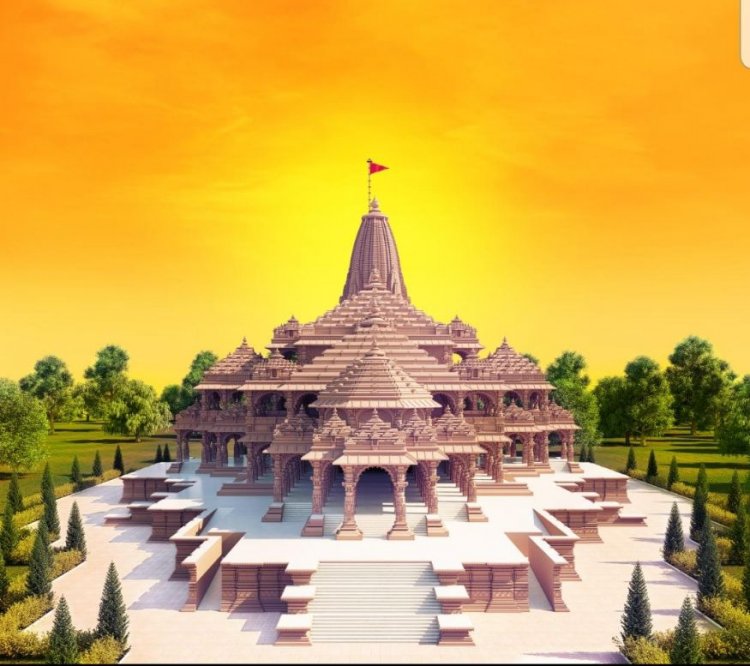The Ram Temple in Ayodhya: Embedded in the Hindu Psyche
Asia News Agency

Prime Minister Narendra Modi will inaugurate the Shri Ram Janmabhoomi Temple in Ayodhya on January 22. The consecration ceremony will involve the installation of the idol of Ram Lalla in the sanctum-sanctorum of the temple. Devotees will be permitted entry to the grand temple starting from January 24.
The euphoria over the upcoming inauguration of the Ram Mandir in Ayodhya, at the very site where the Babri Masjid stood, is so strong over the Indian psyche today "that it prevails over pressing issues such as unemployment, inequality and repression of independent opinion,” according to Neera Chandhoke (Political Scientist).
Some features of the Temple
- The temple is designed in the traditional architectural style popular in the regions around Malwa, Rajputana and Kalinga
- The temple's dimensions are as follows: length (east to west) - 380 feet, width - 250 feet, and height - 161 feet.
- It will be a three-story structure with each floor having a height of 20 feet. The temple will have a total of 392 pillars and 44 gates.
- The main sanctum will house a child form of Lord Shri Ram
- The temple will include 5 pavilions: Dance, Color, ‘Sabha’ (Assembly) , Prayer, and ‘Kirtan’ (prayer) Pavilions.
- Pillars and walls will be adorned with carved statues of Gods and Goddesses.
- A rectangular wall surrounding the temple will be 732 metres in total length and 14 feet in width.
- Six temples dedicated to Sun God, Lord Shiva etc will be constructed at the four corners of the park
- ‘Sitakoop’ (Ram’s wife, Sita's well) from the mythological period will be present near the temple.
- The temple construction avoids the use of iron, and there is no concrete on the ground.
- A 14-metre thick Roller Compacted Concrete (RCC) foundation has been laid under the temple, resembling an artificial rock.
- A 21-foot-high plinth made of granite has been constructed to protect the temple from soil moisture.
- Independent facilities like a sewer treatment plant, water treatment plant, water system for fire fighting, and a power station have been built within the temple complex, minimising dependence on external resources.
- A Pilgrims Facility Center with a capacity of 25,000 is being constructed, providing lockers, medical facilities, and amenities for pilgrims.
- The temple is constructed following Indian tradition and using indigenous technology, with a focus on environmental conservation. Of the total 70-acre area, 70% will remain green forever.
- The estimated cost of the temple's construction is expected to range between ₹ 1,400 crore to ₹ 1,800 crore. The temple trust is receiving donations ranging from ₹ 60-70 lakh for the construction.
Rise of Hindu nationalism
In the view of Swapan Dasgupta (journalist and right wing politician) “to a small but influential section of Indians, soaked in either cultural cosmopolitanism or political progressivism, the excitement over the Ram temple in Ayodhya is inextricably linked to the forthcoming general election. Such a perception is valid if it is assumed that contrived Hindu religiosity with an unmistakable political thrust arrived on the Indian landscape with the coming to power of Prime Minister Narendra Modi. Countless books and articles have been written over the past decade documenting the supposed advent of majoritarian rule in India and the way the Bharatiya Janata Party has disfigured the ‘idea of India’. At the heart of these agonised outpourings is the conviction that what is being promoted as the Hindu inheritance is a collation of kitsch, so far removed from the tasteful, personalised religion of our grandmothers. Lord Ram, it will be loudly claimed……resides in the ‘heart’ and not in a temple consecrated by Modi.”
It is pertinent to recall that it was former BJP leader and former Home Minister L.K. Advani, who mobilised the ‘greatest mass movement’ through his Ayodhya ‘yatra’ across the country that culminated in Ayodhya resulting in the demolition of the centuries old Babri mosque, by Hindu volunteers. The political gains were substantial and resulted in the BJP forming coalitions and later independent governments at the Centre. With and after Advani’s ‘yatra’, Dasgupta states “the Hindu nationalism of the BJP had acquired a more socially representative character…..” Ayodhya and the Ram temple was the key in getting BJP the mass support it now has.
Where the Left and the ‘secular fundamentalists’ in the Congress seriously miscalculated “was in seeing the Ayodhya movement as something detached from mainstream Hindu beliefs….”
Today, amid the public euphoria over the temple, Dasgupta argues “it is hard to believe that pro-temple voices were not deemed respectable in the corridors of power until the BJP’s victory in 2014…..The Hindu vote bank has seen a further enlargement under Modi, not least because it has got linked to economic growth, targeted welfarism and an explosion in national pride.
“In the aftermath of the demolition of the Babri mosque in 1992, secular poseurs claimed that anything was better than a Ram temple at the site. Three decades later, few would care to be so outrageous….”
















